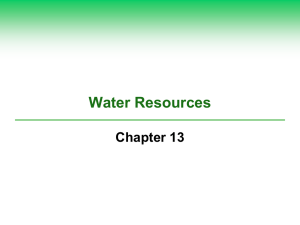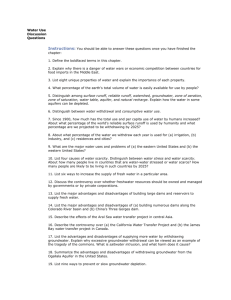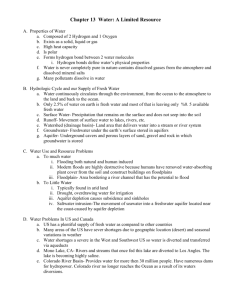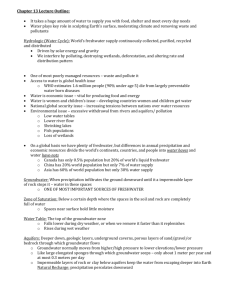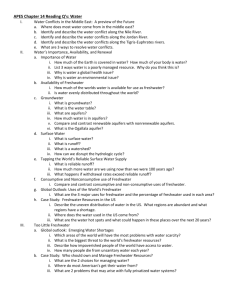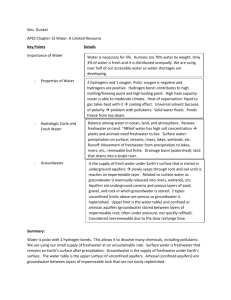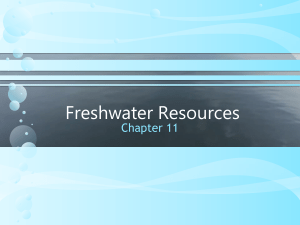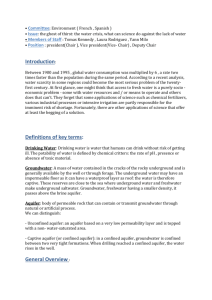Chapter 13 Water Resources
advertisement
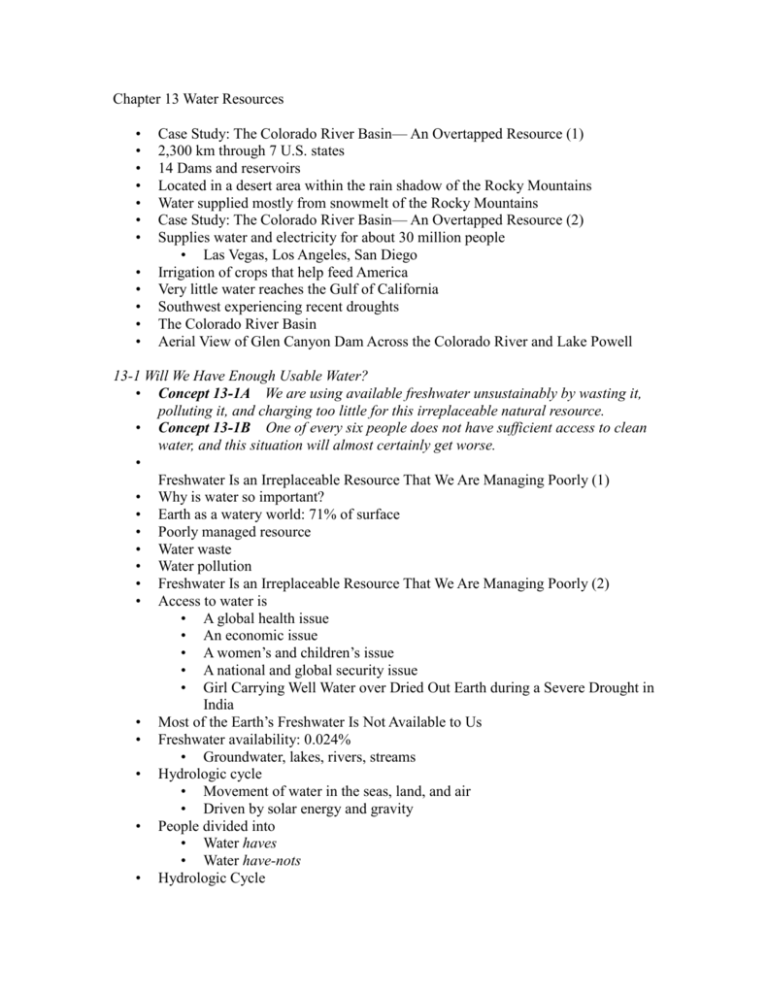
Chapter 13 Water Resources • • • • • • • • • • • • Case Study: The Colorado River Basin— An Overtapped Resource (1) 2,300 km through 7 U.S. states 14 Dams and reservoirs Located in a desert area within the rain shadow of the Rocky Mountains Water supplied mostly from snowmelt of the Rocky Mountains Case Study: The Colorado River Basin— An Overtapped Resource (2) Supplies water and electricity for about 30 million people • Las Vegas, Los Angeles, San Diego Irrigation of crops that help feed America Very little water reaches the Gulf of California Southwest experiencing recent droughts The Colorado River Basin Aerial View of Glen Canyon Dam Across the Colorado River and Lake Powell 13-1 Will We Have Enough Usable Water? • Concept 13-1A We are using available freshwater unsustainably by wasting it, polluting it, and charging too little for this irreplaceable natural resource. • Concept 13-1B One of every six people does not have sufficient access to clean water, and this situation will almost certainly get worse. • Freshwater Is an Irreplaceable Resource That We Are Managing Poorly (1) • Why is water so important? • Earth as a watery world: 71% of surface • Poorly managed resource • Water waste • Water pollution • Freshwater Is an Irreplaceable Resource That We Are Managing Poorly (2) • Access to water is • A global health issue • An economic issue • A women’s and children’s issue • A national and global security issue • Girl Carrying Well Water over Dried Out Earth during a Severe Drought in India • Most of the Earth’s Freshwater Is Not Available to Us • Freshwater availability: 0.024% • Groundwater, lakes, rivers, streams • Hydrologic cycle • Movement of water in the seas, land, and air • Driven by solar energy and gravity • People divided into • Water haves • Water have-nots • Hydrologic Cycle • • • • • • • • • • • • • • • • • • • • • Groundwater and Surface Water Are Critical Resources (1) Zone of saturation • Spaces in soil are filled with water Water table • Top of zone of saturation Aquifers • Natural recharge • Lateral recharge Groundwater and Surface Water Are Critical Resources (2) Surface Water • Surface runoff • Watershed (drainage) basin • We Use Much of the World’s Reliable Runoff 2/3 of the surface runoff: lost by seasonal floods 1/3 is reliable runoff = usable World-wide averages • Domestic: 10% • Agriculture: 70% • Industrial use: 20% Science Focus: Water Footprints and Virtual Water (1) Water footprint • Volume of water we directly and indirectly • Average American uses 260 liters per day • Flushing toilets, 27% • Washing clothes, 22% • Taking showers, 17% • Running faucets, 16% • Wasted from leaks, 14% • World’s poorest use 19 liters per day Science Focus: Water Footprints and Virtual Water (2) More water is used indirectly = virtual water • Hamburger, 2400 liters • Virtual water often exported/imported • Grains and other foods Virtual Water Use Case Study: Freshwater Resources in the United States More than enough renewable freshwater, unevenly distributed and polluted Effect of • Floods • Pollution • Drought 2007: U.S. Geological Survey projection • Water hotspots Average Annual Precipitation and Major Rivers, Water-Deficit Regions in U.S. Water Hotspots in 17 Western U.S. States Water Shortages Will Grow (1) • • • • • • • • Dry climates Drought Too many people using a normal supply of water Wasteful use of water Water Shortages Will Grow (2) China and urbanization 30% earth’s land area experiences severe drought • Will rise to 45% by 2059 from climate change • Potential conflicts/wars over water • Refugees from arid lands • Increased mortality Natural Capital Degradation: Stress on the World’s Major River Basins 13-2 Is Extracting Groundwater the Answer? • Concept 13-2 Groundwater used to supply cities and grow food is being pumped from aquifers in some areas faster than it is renewed by precipitation. • Groundwater is Being Withdrawn Faster Than It Is Replenished (1) • Most aquifers are renewable • Aquifers provide drinking water for half the world • Water tables are falling in many parts of the world, primarily from crop irrigation • Groundwater is Being Withdrawn Faster Than It Is Replenished (2) • India, China, and the United States • Three largest grain producers • Overpumping aquifers for irrigation of crops • India and China • Small farmers drilling tubewells • Effect on water table • Saudi Arabia • Aquifer depletion and irrigation • Trade-Offs: Withdrawing Groundwater, Advantages and Disadvantages • Natural Capital Degradation: Irrigation in Saudi Arabia Using an Aquifer • Case Study: Aquifer Depletion in the United States • Ogallala aquifer: largest known aquifer • Irrigates the Great Plains • Very slow recharge • Water table dropping • Government subsidies to continue farming deplete the aquifer further • Biodiversity threatened in some areas • California Central Valley: serious water depletion • Natural Capital Degradation: Areas of Greatest Aquifer Depletion in the U.S. • Kansas Crops Irrigated by the Ogallala Aquifer • Overpumping Aquifers Has Several Harmful Effects • Limits future food production • Bigger gap between the rich and the poor • Land subsidence • • • • • • • Mexico City • San Joaquin Valley in California Groundwater overdrafts near coastal regions • Contamination of groundwater with saltwater Subsidence in the San Joaquin Valley Solutions: Groundwater Depletion, Prevention and Control Deep Aquifers Might Be Tapped May contain enough water to provide for billions of people for centuries Major concerns • Nonrenewable • Little is known about the geological and ecological impacts of pumping deep aquifers • Some flow beneath more than one country • Costs of tapping are unknown and could be high 13-3 Is Building More Dams the Answer? • Concept 13-3 Building dam-and-reservoir systems has greatly increased water supplies in some areas, but it has disrupted ecosystems and displaced people. • Large Dams and Reservoirs Have Advantages and Disadvantages (1) • Main goal of a dam and reservoir system • Capture and store runoff • Release runoff as needed to control: • Floods • Generate electricity • Supply irrigation water • Recreation (reservoirs) • Large Dams and Reservoirs Have Advantages and Disadvantages (2) • Advantages • Increase the reliable runoff available • Reduce flooding • Grow crops in arid regions • Large Dams and Reservoirs Have Advantages and Disadvantages (3) • Disadvantages • Displaces people • Flooded regions • Impaired ecological services of rivers • Loss of plant and animal species • Fill up with sediment • Can cause other streams and lakes to dry up • Advantages and Disadvantages of Large Dams and Reservoirs • A Closer Look at the Overtapped Colorado River Basin (1) • Only small amount of Colorado River water reaches Gulf of California • Threatens aquatic species in river and species that live in the estuary • Current rate of river withdrawal is not sustainable • Much water used for agriculture that is inefficient with water use: cotton, alfalfa, rice • • • • Water use subsidized by government A Closer Look at the Overtapped Colorado River Basin (2) Reservoirs • Leak water into ground below • Lose much water through evaporation • Fill up with silt load of river, depriving delta • Could eventually lose ability to store water and create electricity • States must conserve water, control population, and slow urban development The Flow of the Colorado River Measured at Its Mouth Has Dropped Sharply 13-4 Is Transferring Water from One Place to Another the Answer? • Concept 13-4 Transferring water from one place to another has greatly increased water supplies in some areas, but it has also disrupted ecosystems. • California Transfers Water from Water-Rich Areas to Water-Poor Areas • Water transferred from north to south by • Tunnels • Aqueducts • Underground pipes • California Water Project • Inefficient water use • Environmental damage to Sacramento River and San Francisco Bay • Southern California Lettuce Grown with Northern California Water • The California Water Project and the Central Arizona Project • Case Study: The Aral Sea Disaster (1) • Large-scale water transfers in dry central Asia • Salinity • Wetland destruction and wildlife • Fish extinctions and fishing declines • Case Study: The Aral Sea Disaster (2) • Wind-blown salt • Water pollution • Restoration efforts • Cooperation of neighboring countries • More efficient irrigation • Dike built to raise lake level • Natural Capital Degradation: The Aral Sea, Shrinking Freshwater Lake 13-5 Is Converting Salty Seawater to Freshwater the Answer? • Concept 13-5 We can convert salty ocean water to freshwater, but the cost is high, and the resulting salty brine must be disposed of without harming aquatic or terrestrial ecosystems. • Removing Salt from Seawater Is Costly, Kills Organisms, Creates Briny Wastewater (1) • Desalination • Removing dissolved salts • • • • • • • Distillation: evaporate water, leaving salts behind • Reverse osmosis, microfiltration: use high pressure to remove salts 14,450 plants in 125 countries • Saudi Arabia: highest number Removing Salt from Seawater Is Costly, Kills Organisms, Creates Briny Wastewater (2) Problems • High cost and energy footprint • Keeps down algal growth and kills many marine organisms • Large quantity of brine wastes Science Focus: The Search for Improved Desalination Technology Desalination on offshore ships • Solar or wind energy • Use ocean waves for power Build desalination plants near electric power plants 13-6 How Can We Use Water More Sustainably? • Concept 13-6 We can use water more sustainably by cutting water waste, raising water prices, slowing population growth, and protecting aquifers, forests, and other ecosystems that store and release water. • Reducing Water Waste Has Many Benefits • One-half to two-thirds of water is wasted • Subsidies mask the true cost of water • Water conservation • Improves irrigation efficiency • Improves collection efficiency • Uses less in homes and businesses • We Can Cut Water Waste in Irrigation • Flood irrigation • Wasteful • Center pivot, low pressure sprinkler • Low-energy, precision application sprinklers • Drip or trickle irrigation, microirrigation • Costly; less water waste • Major Irrigation Systems • Solutions: Reducing Irrigation Water Waste • Less-Developed Countries Use Low-Tech Methods for Irrigation • Human-powered treadle pumps • Harvest and store rainwater • Create a polyculture canopy over crops: reduces evaporation • Treadle Pump in Bangladesh • We Can Cut Water Waste in Industry and Homes • Recycle water in industry • Fix leaks in the plumbing systems • Use water-thrifty landscaping: xeriscaping • • • • • • • • • Use gray water Pay-as-you-go water use • Solutions: Reducing Water Waste Xeriscaping in Southern California We Can Use Less Water to Remove Wastes Can we mimic how nature deals with waste? Use human sewage to create nutrient-rich sludge to apply to croplands Waterless composting toilets Solutions: Sustainable Water Use What Can You Do? Water Use and Waste 13-7 How Can We Reduce the Threat of Flooding? • Concept 13-7 We can lessen the threat of flooding by protecting more wetlands and natural vegetation in watersheds, and by not building in areas subject to frequent flooding. • Some Areas Get Too Much Water from Flooding (1) • Flood plains • Highly productive wetlands • Provide natural flood and erosion control • Maintain high water quality • Recharge groundwater • Benefits of floodplains • Fertile soils • Nearby rivers for use and recreation • Flatlands for urbanization and farming • Some Areas Get Too Much Water from Flooding (2) • Human activities make floods worse • Levees can break or be overtopped • Paving and development increase runoff • Removal of water-absorbing vegetation • Draining wetlands and building on them • Rising sea levels from global warming means more coastal flooding • Natural Capital Degradation: Hillside Before and After Deforestation • Deforestation Above China’s Yangtze River Contribute to Erosion and Floods • Case Study: Living Dangerously on Floodplains in Bangladesh • Dense population on coastal floodplain • Moderate floods maintain fertile soil • Increased frequency of large floods • Effects of development in the Himalayan foothills • Destruction of coastal wetlands: mangrove forests • We Can Reduce Flood Risks • Rely more on nature’s systems • Wetlands • Natural vegetation in watersheds • Rely less on engineering devices • Dams • Levees • Channelized streams • Solutions: Reducing Flood Damage • Three Big Ideas 1. One of the world’s major environmental problems is the growing shortage of freshwater in many parts of the world. 2. We can increase water supplies in water-short areas in a number of ways, but the most important way is to reduce overall water use and waste by using water more sustainably. 3. We can use water more sustainably by cutting water waste, raising water prices, slowing population growth, and protecting aquifers, forests, and other ecosystems that store and release water.


